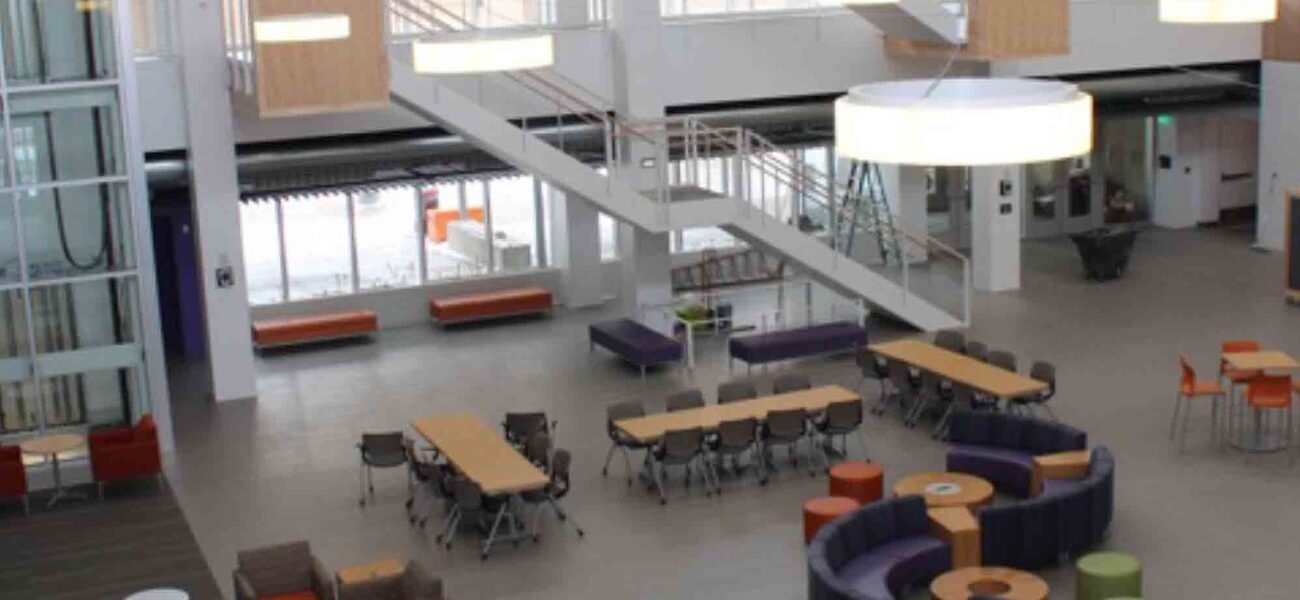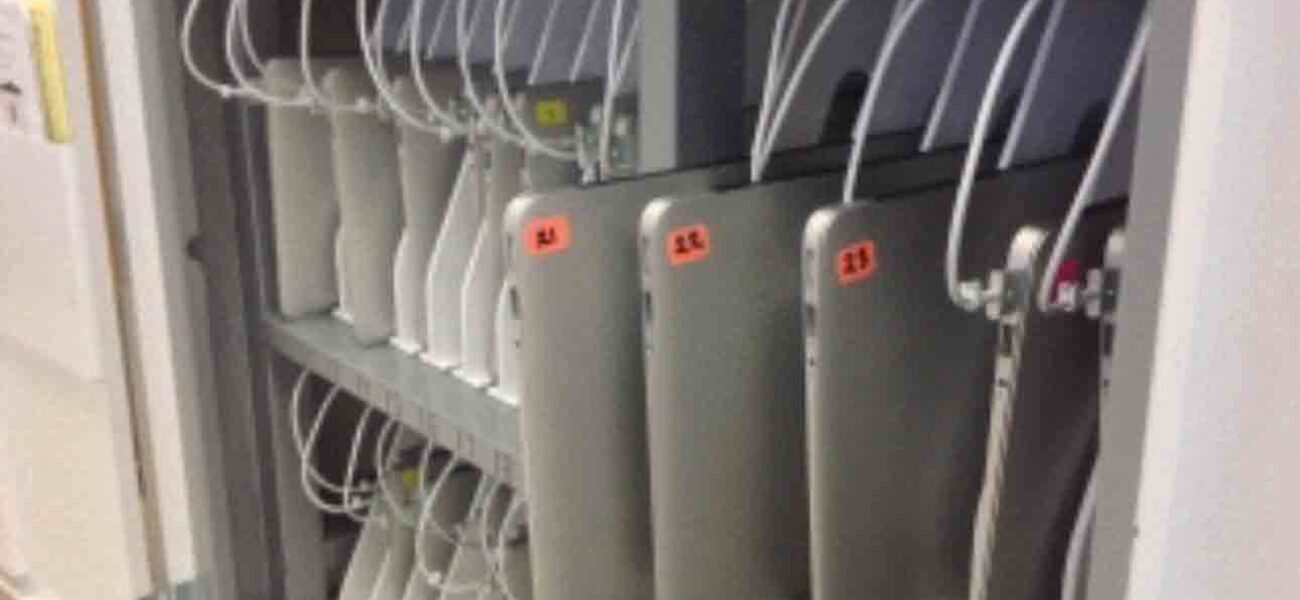With the second-lowest population density of any state in the US and two cows for every human, Wyoming has long been a land of wide-open spaces, except for science students at the University of Wyoming. For decades, UW students have studied science in “dingy, dark, old basement labs,” says Daniel Dale, department head and professor of physics and astronomy at the University of Wyoming. But a new building has changed all of that—with active learning spaces, abundant natural light, and a new emphasis on collaboration—and increased student attendance and performance to boot.
The Enzi STEM Facility is a wide-open space where the University of Wyoming science community can run free. Since its opening in January 2016, the $55 million, 107,000-sf building has been ushering in a new era of science instruction. Housing 32 introductory science labs for physics, chemistry, biology, computer science, and mathematics on its three floors, Enzi embodies exploration, collaboration, and integration.
The plan, described by Dale as “basically a hollow cube,” places lab spaces at the perimeter and a sun-filled atrium at the center. Sporting a prominent, open, multilevel stair and furnished with a variety of seating options—tables of different shapes and sizes, linear and curvilinear couches with coffee tables, and stuffed chairs arranged around small living room areas—the atrium is an attractive “collision space” in which students love to study. Those preferring enclosure and solitude can seek refuge in a glass-walled study area adjacent to the atrium, or in glass-walled rooms on the second and third floors designed for small groups of six to 12 students.
Walls That Break Down Walls
The walls in Enzi do more than just partition space: They are themselves spaces for learning.
“If there is a place to write on the boards and walls for students, we have taken advantage of it,” says Dale. “In the atrium, we are using glass walls specifically designed for drawing and writing on. In the labs, we are using all available wall space for additional writing and drawing—both writable painted walls and Walltalkers® dry-erase wallcoverings. And throughout the building, there are many fixed and movable walls that are designed for hanging posters, as is done at science conferences.”
Short-throw projectors with motion sensors allow regular walls to be converted to smartboards; after writing all over a wall, a teacher can electronically save what they have written and email it to students.
Mondopads—large touchscreens suitable for videoconferencing and other multimedia applications—are another way to write on the walls. “In general, they are simply for students to gather around for doing group work,” says Dale. In the atrium, four Mondopads are mounted on the movable walls. Two Mondopads are provided in each of the glassed-in study areas on the second and third floors, and two in the first-floor hallways. Off-duty, the Mondopads loop through depictions of various STEM career options.
Making the walls into learning spaces promotes an active-learning mindset by encouraging inhabitants to claim their environment, mark their territory, and see boundaries as malleable and dynamic. “We are trying to get students to physically get up and move around, circulate, and work with others,” says Dale.
The transparent glass walls abundant in Enzi achieve multiple design goals. In addition to allowing daylight to flow freely through interior spaces, they place science on display. “When students walk by, they can see what is going on in the classrooms,” says Dale. “Perhaps a business major will get jazzed about taking science and will take more science than just their required classes for their degree program.” In chemistry labs, transparent walls and see-through fume hoods enhance safety and surveillance.
Studio Physics and STEM Suites
The traditional wall between theory and practice dissolves in studio physics, a new teaching approach that Dale has spearheaded at the University of Wyoming. In the physics studio, which seats 56 students, teachers move back and forth freely between experiment and theory, according to whatever is most appropriate at the time.
“It has been fantastic,” says Dale. “Instead of having lectures on Monday, Wednesday, and Friday, and recitations Tuesday and Thursday, we hold three 100-minute meetings each week that combine lecture and recitation elements, and the professor and the TAs are all there. I find there is a much deeper connection with my students that way.
“I consider studio the pinnacle of active learning. You can have active-learning lectures, but studio on top of that allows you to have the lab equipment there, as well, to do the hands-on, inquiry-based labs.”
“Attendance has gone way up,” says Dale. “When I used to teach the traditional auditorium, theater-style seating, I might get 65 or 70 percent attendance. But I’ve been getting 97 percent attendance in my studio classes. And the numbers of dropouts and students receiving Ds and Fs are down about 50 percent.”
The physics studio has been a labor of love for Dale. “It is the only space in the whole building specifically designed for combining a lecture and laboratory experience,” he says. “All of the other 31 rooms were designed as lab spaces. I was able to carve it out of the budget and the architects by working intensively with the design team. I was really invested in creating an amazing teaching space for my department.”
Another variation on the standard teaching lab are three “STEM suites,” one per floor, that include both a traditional hands-on lab space and a dry lab space for write-ups, analysis, and computational work. The spaces are connected by a sliding glass wall that both visually connects the spaces and enhances safety by aiding surveillance. Writeable and projectable walls, Mondopads, ceiling-mounted carriers, and movable tables and chairs maximize flexibility for lectures, demonstrations, and hands-on exercises. Several faculty use the STEM suites for studio-style teaching.
Dale would have liked to do even more, and he will soon get his chance: Plans are in the works for another STEM building that will take the active-learning model to the next level, with a 200-seat active-learning classroom.
Vast Improvement
Enzi’s lab spaces are a world apart from what came before. Daylight streams in, ventilation is quiet, benches and counters are more spacious, and sinks and drying racks are more available and accessible. Each student gets a lockable lab drawer for glassware, goggles, and calculators; laptops are tucked away in a wheeled storage cart called a COW—short for “computer on wheels”—equipped with chargers, to charge laptop batteries while students work in the lab. Demonstration fume hoods equipped with cameras allow students to see what the teacher is doing under the hood without leaving their seats.
Enzi is a new world for faculty too. “My math department head said what he likes best about this facility is just being with other STEM departments,” says Dale. “Faculty from different departments have begun working on interdisciplinary ideas because this facility is making us collide. ‘Collision space’ happens in teaching labs, as well as research labs.”
New Frontiers
Some issues remain to be worked out: how much of the IT bill the science departments should foot, given that the building is a centralized resource delivering service courses to the general UW student population; how to optimally secure the building (One solution has been to move a custodial staff hub into the building to provide a 24-7 staff presence.); and how best to visually celebrate science in the building.
“I’m disappointed that we didn’t get more art into this,” says Dale. “I’d love to see a Foucault pendulum or a planet walk or a double helix or some kind of whale skeleton hanging from the ceiling, but at this point we’re just painting physics equations on the walls.”
Whether or not the donor materializes for the building’s art program, however, Enzi is nevertheless both an unqualified success and a great first step in a northerly campus expansion aimed at transforming STEM at UW. As a researcher in the field of galaxies, Dale was no stranger to thinking about space. But Enzi marks the beginning of a new journey for Dale, into a universe of possibilities for STEM learning environments—spaces where the minds of UW science students and faculty can roam free.
Deborah Kreuze


